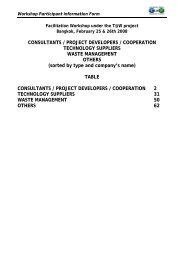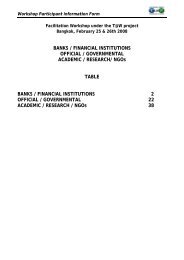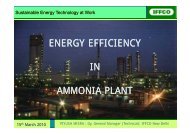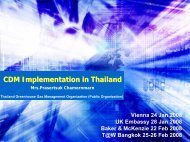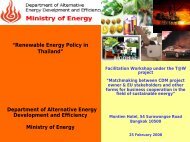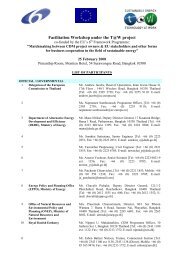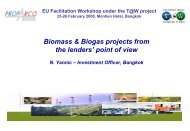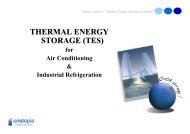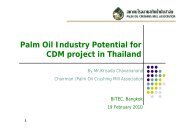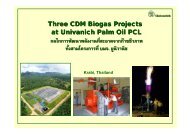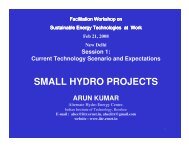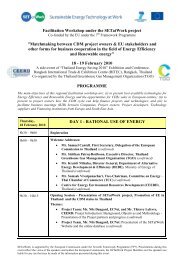Malaysia - SETatWork - Sustainable Energy Technology at Work
Malaysia - SETatWork - Sustainable Energy Technology at Work
Malaysia - SETatWork - Sustainable Energy Technology at Work
Create successful ePaper yourself
Turn your PDF publications into a flip-book with our unique Google optimized e-Paper software.
4 SET Opportunities<br />
<strong>Malaysia</strong> is well endowed with both conventional (non-renewable) and non-conventional<br />
(renewable) sources of energy. The renewable energy resources in <strong>Malaysia</strong> includes<br />
biomass, solar, wind and geothermal. The st<strong>at</strong>us and trends in the potential of these<br />
renewable energy technologies transferred to <strong>Malaysia</strong> and the potential of the<br />
renewable energy projects for the st<strong>at</strong>us of Clean Development Mechanism will be<br />
discussed in the l<strong>at</strong>er section.<br />
In the year 2001, the Ministry of <strong>Energy</strong>, W<strong>at</strong>er and Communic<strong>at</strong>ions (formerly known as<br />
the Ministry of <strong>Energy</strong>, Communic<strong>at</strong>ions and Multimedia) launched the Small Renewable<br />
<strong>Energy</strong> Power (SREP) programme to facilit<strong>at</strong>e the implement<strong>at</strong>ion of grid-connected<br />
power gener<strong>at</strong>ion utilising renewable energy resources. The launch of the SREP is among<br />
the steps taken by the Government to encourage and intensify the utilis<strong>at</strong>ion of<br />
renewable energy in power gener<strong>at</strong>ion. This is in line with the government’s decision to<br />
intensify the development of renewable energy as the fifth fuel resource under the<br />
country’s Fuel Diversific<strong>at</strong>ion Policy, as stipul<strong>at</strong>ed in the objectives of the Third Outline<br />
Perspective Plan for 2000 – 2010 (OPP3) and the Eight <strong>Malaysia</strong> Plan.<br />
Small power gener<strong>at</strong>ion plants which utilise renewable energy can apply to sell electricity<br />
to the Utility through the Distribution Grid System. Project developers are required to<br />
negoti<strong>at</strong>e directly with the relevant Utility on all aspects rel<strong>at</strong>ing to the Renewable<br />
Electricity Purchase Agreement, including the selling price on a “willing-seller, willing<br />
buyer” and “take and pay” basis. The Renewable <strong>Energy</strong> electricity producers will be<br />
given a licence for a period of 21 years, which will be effective from the d<strong>at</strong>e of<br />
commissioning of the plant. Under this Small Renewable <strong>Energy</strong> Power Programme, the<br />
utilis<strong>at</strong>ion of all types of Renewable <strong>Energy</strong>, including biomass, biogas, municipal waste,<br />
solar, mini-hydro and wind, are allowed.<br />
Maximum capacity of a small renewable energy plant designed for sale of power to the<br />
grid must be 10 MW. A power plant can be more than 10 MW in size, but the maximum<br />
capacity th<strong>at</strong> will be allowed for power export to the distribution grid must not be more<br />
than 10 MW.<br />
In order to co-ordin<strong>at</strong>e the implement<strong>at</strong>ion of the Government’s str<strong>at</strong>egy to intensify the<br />
development of Renewable <strong>Energy</strong> as the country’s fifth fuel resource, a Special<br />
Committee on Renewable <strong>Energy</strong> (SCORE) has been set up under the Ministry of <strong>Energy</strong>,<br />
W<strong>at</strong>er and Communic<strong>at</strong>ions.<br />
14



